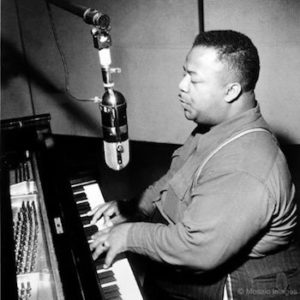
Meade Lux Lewis
*On this date, in 1905, Meade Lux Lewis was born. He was a Black jazz and Boogie-Woogie pianist.
Lewis was born in Chicago, Illinois, and helped establish boogie-woogie as a major blues piano style in the 1930s and 1940s. In 1938, Lewis took the rollicking piano form out of the clubs and cat houses and onto the concert stage, where its fast-flowing rhythms and charging solos delighted audiences and eventually laid the groundwork for rhythm and blues and later rock and roll.
Lewis was a master boogie-woogie craftsman. Such boogie-woogie pioneers as Jimmy Yancey and Pine Top Smith heavily influenced him. Lewis recorded "Honky Tonk Train Blues," his signature piece and a standard in the boogie-woogie repertoire, in 1927, though Paramount Records didn't release it until two years later.
The piece ranks with "Yancey Special" and "Pine Top's Boogie-Woogie" as the greatest recorded early examples of boogie-woogie piano. Lewis met Albert Ammons, a fellow piano player who, like Lewis, drove a taxi for a living. Eventually, they shared an apartment in the same building where Pine Top Smith lived. All three pianists became good friends, often sharing ideas and jamming together. It is not surprising then that Lewis's "Honky Tonk Train Blues" bears a striking resemblance to Smith's "Pine Top's Boogie Woogie."
After the death of Smith in 1929 at age twenty-five and the onset of the Depression, interest in boogie-woogie faded, forcing Lewis to seek other forms of employment to supplement his meager income from playing the piano. Despite boogie-woogie's decline, Lewis continued to record in the 1930s, occasionally cutting sides as a session man playing behind singers George Hannah and Bob Robinson. Lewis and Ammons were key figures in the boogie-woogie renaissance of the late 1930s and early 1940s. Talent scout John Hammond contacted him to play his 1938 Spirituals to Swing concert at Carnegie Hall in New York City. Lewis, along with Ammons and fellow pianist Pete Johnson, so excited concert-goers with their bristling boogie-woogie piano passages that the music's second craze began then and there.
Lewis and his colleagues were booked to play the Café Society, a chic Manhattan club where the best boogie-woogie would be heard through 1941. Lewis remained in New York until that year when interest in boogie-woogie began to wither again. He relocated to Los Angeles and resumed his club work and recording career. Lewis recorded for the ASCH label in 1944, though he and boogie-woogie were no longer vital to the blues scene. He also continued to perform, usually in small clubs and lounges. Lewis died in an automobile crash in Minneapolis on February 7th, 1964.
All About Jazz
761 Sproul Road, #211
Springfield, PA 19064